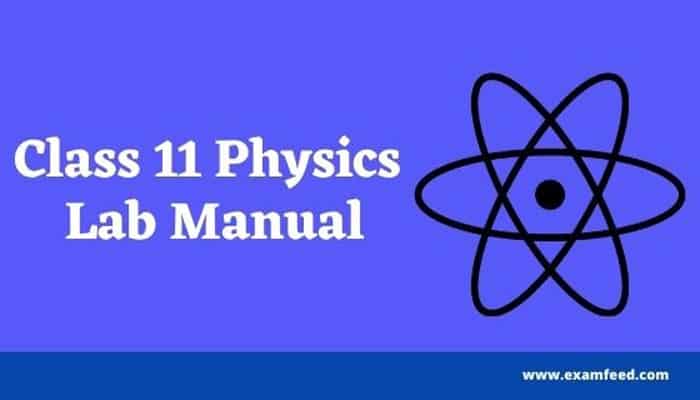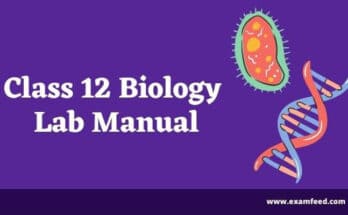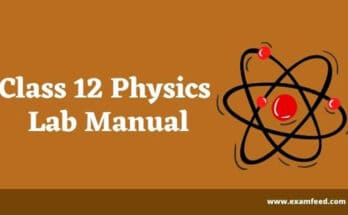CBSE Class 11 Physics Lab Manual is a very reliable source provided by CBSE to Students. The Physics Practical for Class 11 lab manual consists of various experiments. It is provided in a very well structured manner so that students can understand the concepts and perform the class 11 physics experiments along with the laws, theorems, and numerical.

In this article, we have listed physics practical for class 11 CBSE students. With the help of this list of physics practical class 11 solved pdf helps you better prepare for the practical exam.
Physics Practical for Class 11 Lab Manual
Below we have mentioned the class 11 physics practical manual pdf. Students need to check the complete Class 11 Physics Lab Manual to get good marks in the final practical exam.
| Experiment No. | Aim |
| Experiment No. 1 | Using Vernier Calliper
|
| Experiment No. 2 | Using Screw Gauge to Measure
|
| Experiment No. 3 | By using the Spherometer, Find out the radius of curvature (R) of the given spherical surface. |
| Experiment No. 4 | Using Beam Balance, find out the mass of the two different objects. |
| Experiment No. 5 | By using the law of parallelogram of vectors addition, Calculate the weight of a given body. |
| Experiment No. 6 | Using the Simple Pendulum, Plot a graph L against T and L against T2 graphs. Hence calculating the effective length of the second pendulum. |
| Experiment No. 7 | To study the relation between the force of limiting friction and normal reaction. To find out the coefficient of friction (μ) between the horizontal surface and block. |
| Experiment No. 8 | To find the downward force, along an inclined plane, acting on a roller due to the gravitational pull of the earth and, To study its relationship with the angle of inclination (θ) by plotting the graph force against sin θ. |
| Experiment No. 9 | To Calculate Young’s modulus of elasticity of the material of a given wire. |
| Experiment No. 10 | By plotting the graph load against the extension, Determine the force constant of the helical spring |
| Experiment No. 11 | By plotting the graphs of P & V, and against P & 1/V, A Study of the variation in the volume with the pressure at a constant temperature for a sample of air. |
| Experiment No. 12 | By Capillary rise method, Determine the surface tension of the water. |
| Experiment No. 13 | By measuring the terminal velocity of the given spherical body. Find out the coefficient of viscosity (η) of the given viscous liquid |
| Experiment No. 14 | By plotting a cooling curve. Study the relationship between the time and temperature of a hot body. |
| Experiment No. 15 | By using Somometer,
|
| Experiment No. 16 | By using the method of mixtures, calculating the specific heat capacity (cp) of
|
| Experiment No. 17 | To determine the speed of the sound in the air at room temperature by using a resonance tube by two resonance positions. |
Physics Practical for Class 11 CBSE Students – Activity
The following are the practical of physics class 11 CBSE – Activities:-
| Activity Number | Aim |
| Activity 1 | To make a paper scale of the given least count (LC), for example, 0.2cm, 0.5 cm. |
| Activity 2 | To calculate the mass of the given body by using a meter scale by the principle of moments. |
| Activity 3 | To plot a graph for a given set of data, with the error bars and proper choice of scales. |
| Activity 4 | To compute the force of limiting friction for rolling of a roller on a horizontal plane. |
| Activity 5 | Study of the variation in the scale of the projectile with the angle of projection. |
| Activity 6 | A Study of the conservation of energy on a ball rolling down on an inclined plane (by using the double inclined plane). |
| Activity 7 | By plotting a graph of the square of amplitude against time study the dissipation of the energy of the simple pendulum. |
| Activity 8 | To Study and observe the change of the state and for molten wax plot a cooling curve. |
| Activity 9 |
To Study, observe, and describe the heating effects on a bi-metallic strip. |
| Activity 10 | To observe the change in the level of liquid in a container on the heating and interpreting the observations. |
| Activity 11 | To study the detergent effects on the surface tension of the water by observing the capillary rise. |
| Activity 12 | To study the factors influencing the rate of loss of heat of a liquid. |
| Activity 13 | To study various load effects on the depression of the suitably clamped meter scale loaded at (1) its end (2) in the middle. |
| Activity 14 | To observe the decrease in the pressure with an increase in the velocity of a fluid. |
Stay tuned to the Exam Feed for project topics, seminar topics, Study Material, Question Papers, and Syllabus, etc.
Also Read:-



